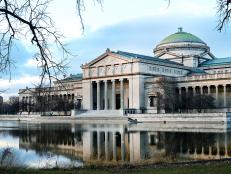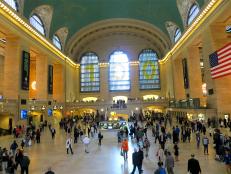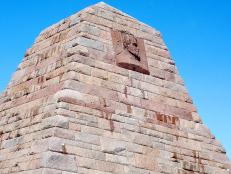Mysteries Behind 18 Famous Monuments
Explorer Don Wildman scoured the country for America’s most extraordinary monuments to reveal the amazing mysteries hidden within on Mysteries at the Monument.

Photo By: Wendy Connett / Robert Harding World Imagery / Getty Images
Photo By: Pond 5
Photo By: Bigstock
Monument Under Siege
The Washington Monument in Washington, DC, is a 555-foot obelisk that was erected as a tribute to the United States’ first president, George Washington. But it has not always been a place for tribute and celebration. In December 1982, it was the scene of a harrowing standoff when anti-nuke activist Norman Mayer parked a truck that he said was filled with explosives at the base of the monument.
Stone of Destiny
In southeastern London, on the banks of the River Thames, lies Westminster Abbey, the coronation church of the British monarchy. The Gothic structure, which is more than 1,000 years old, houses a treasure trove of paintings, stained glass and other artifacts. It is also where many significant figures in English history are buried or honored.
The Day the Falls Shut Off
The American Falls in Niagara Falls, NY — pictured with Canada in the background — were temporarily shut off in 1969 by the Army Corps of Engineers. The group inspected, cleaned and repaired the structure in an effort to preserve the falls for future generations.
Remember the Alamo
The Alamo is one of the biggest tourist destinations in Texas. A former Franciscan mission and way station between Texas and Mexico, the impressive limestone edifice was constructed in 1744 and sits on 4 acres of land. But in 1905, the historic site was on the verge of collapse. That is, until a working-class teacher named Adina De Zavala made it her mission to preserve the Alamo by whatever means necessary.
Take Down That Wall
Berlin is home to the East Side Gallery. Now a popular open-air gallery, this iconic landmark is the longest surviving stretch of the Berlin Wall. It is considered to be an international memorial for freedom and is visited by countless tourists each year. Yet few realize that the Berlin Wall was once the location of one of the most bizarre escape plots of the 20th century.
What Happens in Vegas ...
With more than 150 casinos, it's no wonder that the Las Vegas gaming industry makes over $6 billion annually. Greeting the more than 35 million visitors to the city each year is the iconic “Welcome to Fabulous Las Vegas, Nevada” sign. Designed by Betty Willis and the Western Neon Co., the colorful landmark was added to the National Register of Historic Places in 2009.
Leaning Tower of Pisa
Known throughout the world for its remarkable medieval architecture gone wrong, the Leaning Tower of Pisa has been tilted since its construction. But what people don’t know is that overnight, this Italian treasure went from being an architectural wonder to a vulnerable ancient building on the brink of total collapse, and its fate rested on the shoulders of 1 man.
London's Calling
The Tower of London in England was founded in 1066 under the rule of William the Conqueror. Located north of the River Thames, it has been used over the centuries as a royal palace and a prison. The tower has a rich history, including the disappearance of 2 young princes who, in 1483, were unwittingly involved in a sinister plot and were believed to have been murdered before they could take their rightful places as the heirs to the throne.
Fire in the Hole!
Located just a few blocks away from the Texas state Capitol in Austin stands a statue of local heroine Angelina Eberly. In 1842, this feisty, quick-thinking innkeeper fired the cannon that thwarted Sam Houston's plan to relocate the valuable collection of republic archives from Austin, subsequently preserving the city as the true capital of Texas.
Stonewall Inn
The popular Stonewall Inn tavern in New York City's Greenwich Village became the center of a burgeoning civil rights movement after gay men and lesbians fought back against a routine police raid in 1969.
Hawaiian Style
Honolulu's Royal Hawaiian Hotel has welcomed visitors since 1927. The so-called "Pink Palace of the Pacific" sits on 10 acres of idyllic Waikiki beachfront. Over the years, the luxurious resort has welcomed VIP guests including Shirley Temple, Franklin Roosevelt and Clark Gable.
Mount Everts
This peak in Yellowstone National Park was named after Truman Everts, an explorer who was lost in the wilderness for 37 days in 1870. He had to use every trick up his sleeve to survive.
The US Capitol
The US Capitol building in Washington, DC, is home to the federal legislative branch and the seat of American democracy. But in the 1920s, a mysterious man known as "the Man in the Green Hat" successfully ran an illicit enterprise within its walls and subsequently exposed the glaring problems behind a contentious national law.
The Biggest Little City in the World
The famous Reno Arch greets visitors to the rollicking casino town of Reno, NV. In 1969, a devoutly religious and brilliant engineer named Keith Taft invented an ingenious wearable computing device that helped him excel at counting cards and raking in the profits. This device, affectionately known as "George," would be the first prototype of a portable microcomputer that is prevalent today.
Green-Wood Cemetery
The gates of the historic Green-Wood Cemetery in Brooklyn, NY, where many high-profile New Yorkers of the 19th century wanted to be buried. But it's a forgotten magician, billed as "the first and world-eminent mind reader," who may have the most surprising story of all the residents.
Coventry Cathedral
Coventry Cathedral in England was bombed in World War II, and its remains are preserved by the town and open to the public.
Mount Everest
The Himalayan mountain range boasts more than 100 peaks that rise over 23,000 feet tall. But the tallest of these massive monoliths is the world’s most famous summit — Mount Everest. This precarious peak was once the scene of a fatal disaster that descended into a heated rivalry between climbing experts.
Virginia State Capitol
On the grounds of Virginia's historic state Capitol in Richmond is a striking monument that demands any passer-by’s attention. Standing in front of a 9-foot granite wall is a group of life-size bronze figures, all youthful in appearance. And at the center of the group is its leader — Barbara Rose Johns, a 16-year-old girl who inspired a revolution that had far-reaching consequences for the civil rights movement.






